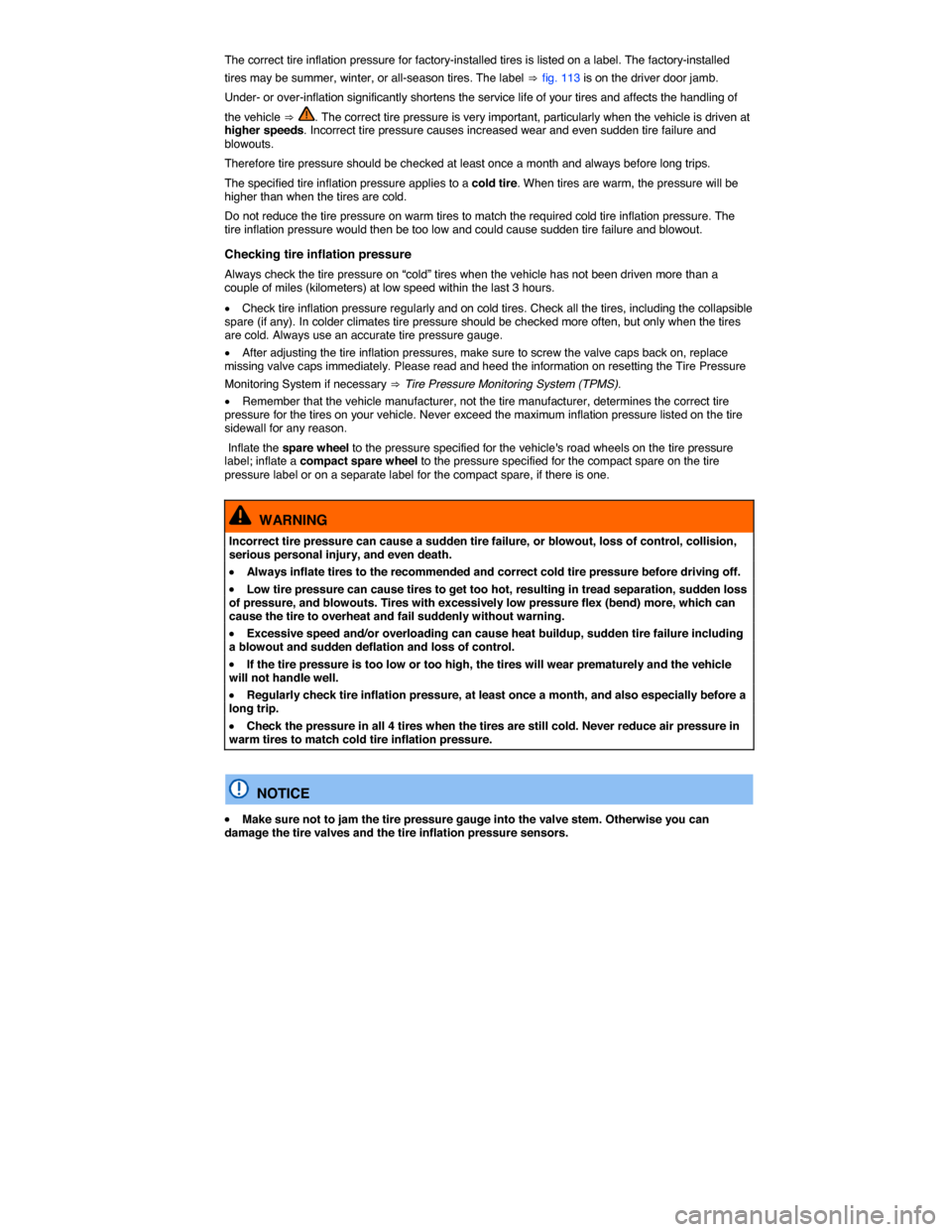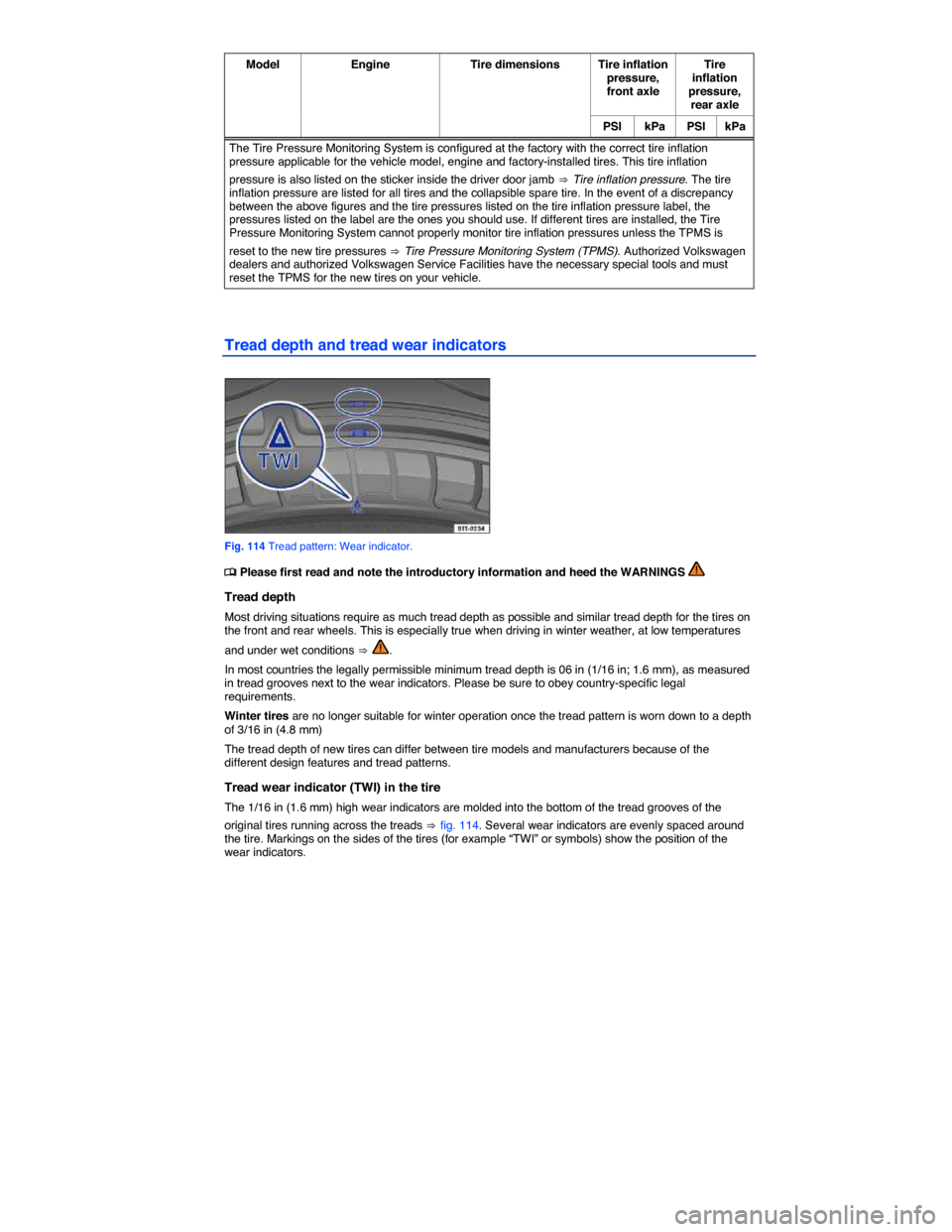2014 VOLKSWAGEN TOUAREG service reset
[x] Cancel search: service resetPage 174 of 620

The correct tire inflation pressure for factory-installed tires is listed on a label. The factory-installed
tires may be summer, winter, or all-season tires. The label ⇒ fig. 113 is on the driver door jamb.
Under- or over-inflation significantly shortens the service life of your tires and affects the handling of
the vehicle ⇒ . The correct tire pressure is very important, particularly when the vehicle is driven at higher speeds. Incorrect tire pressure causes increased wear and even sudden tire failure and blowouts.
Therefore tire pressure should be checked at least once a month and always before long trips.
The specified tire inflation pressure applies to a cold tire. When tires are warm, the pressure will be higher than when the tires are cold.
Do not reduce the tire pressure on warm tires to match the required cold tire inflation pressure. The tire inflation pressure would then be too low and could cause sudden tire failure and blowout.
Checking tire inflation pressure
Always check the tire pressure on “cold” tires when the vehicle has not been driven more than a couple of miles (kilometers) at low speed within the last 3 hours.
�x Check tire inflation pressure regularly and on cold tires. Check all the tires, including the collapsible spare (if any). In colder climates tire pressure should be checked more often, but only when the tires are cold. Always use an accurate tire pressure gauge.
�x After adjusting the tire inflation pressures, make sure to screw the valve caps back on, replace missing valve caps immediately. Please read and heed the information on resetting the Tire Pressure
Monitoring System if necessary ⇒ Tire Pressure Monitoring System (TPMS).
�x Remember that the vehicle manufacturer, not the tire manufacturer, determines the correct tire pressure for the tires on your vehicle. Never exceed the maximum inflation pressure listed on the tire sidewall for any reason.
Inflate the spare wheel to the pressure specified for the vehicle's road wheels on the tire pressure label; inflate a compact spare wheel to the pressure specified for the compact spare on the tire pressure label or on a separate label for the compact spare, if there is one.
WARNING
Incorrect tire pressure can cause a sudden tire failure, or blowout, loss of control, collision, serious personal injury, and even death.
�x Always inflate tires to the recommended and correct cold tire pressure before driving off.
�x Low tire pressure can cause tires to get too hot, resulting in tread separation, sudden loss of pressure, and blowouts. Tires with excessively low pressure flex (bend) more, which can cause the tire to overheat and fail suddenly without warning.
�x Excessive speed and/or overloading can cause heat buildup, sudden tire failure including a blowout and sudden deflation and loss of control.
�x If the tire pressure is too low or too high, the tires will wear prematurely and the vehicle will not handle well.
�x Regularly check tire inflation pressure, at least once a month, and also especially before a long trip.
�x Check the pressure in all 4 tires when the tires are still cold. Never reduce air pressure in warm tires to match cold tire inflation pressure.
NOTICE
�x Make sure not to jam the tire pressure gauge into the valve stem. Otherwise you can damage the tire valves and the tire inflation pressure sensors.
Page 176 of 620

Model Engine Tire dimensions Tire inflation pressure, front axle
Tire inflation pressure, rear axle
PSI kPa PSI kPa
The Tire Pressure Monitoring System is configured at the factory with the correct tire inflation pressure applicable for the vehicle model, engine and factory-installed tires. This tire inflation
pressure is also listed on the sticker inside the driver door jamb ⇒ Tire inflation pressure. The tire inflation pressure are listed for all tires and the collapsible spare tire. In the event of a discrepancy between the above figures and the tire pressures listed on the tire inflation pressure label, the pressures listed on the label are the ones you should use. If different tires are installed, the Tire Pressure Monitoring System cannot properly monitor tire inflation pressures unless the TPMS is
reset to the new tire pressures ⇒ Tire Pressure Monitoring System (TPMS). Authorized Volkswagen dealers and authorized Volkswagen Service Facilities have the necessary special tools and must reset the TPMS for the new tires on your vehicle.
Tread depth and tread wear indicators
Fig. 114 Tread pattern: Wear indicator.
�
Page 527 of 620

Frequently asked questions
If you suspect a malfunction or vehicle damage, read and follow the following advice before contacting an authorized Volkswagen dealer or an authorized Volkswagen Service Facility. You may also find helpful information under “Characteristics” and “Checklist” in the index.
Description Possible causes among others Possible remedy
Engine does not start.
Vehicle battery dead. – Perform jump start – Charge vehicle battery
The wrong remote control vehicle key is used. Use a valid remote control vehicle key
Fuel level too low. Refuel
AdBlue fill level too low. Refill AdBlue
Vehicle cannot be locked or unlocked using remote control vehicle key.
– Battery in remote control vehicle key dead. – Too far away from vehicle. (out of range). – Buttons have been pressed too many times.
– Replace battery –. Move closer to vehicle. – Synchronize remote control vehicle key – Lock or unlock vehicle manually
Unusual noises. Cold engine, brake-assistance systems, electronic parking brake.
Check the “Noises” entry in the keyword index.
Odd driving behavior. Assistance systems activated. Check the “Assistance systems” entry in the keyword index.
Driver seat and outer mirrors move when vehicle is unlocked.
Convenience settings are stored. Correct convenience settings
Memory-seat settings are stored. – Reassign seat setting – Clear memory-seat memory
Front seats cannot be adjusted with power controls.
Vehicle battery dead. Charge vehicle battery
Fuse blown. Check fuse and replace if necessary
No jack in vehicle or no collapsible spare tire or tire mobility set in vehicle.
Equipment differs depending on vehicle. No direct corrective action possible because this depends on the equipment. Contact an authorized Volkswagen dealer or an authorized Volkswagen Service Facility for assistance
Vehicle has mobility tires.
Features do not work as described in this Manual.
Settings were changed in the Volkswagen Information System or Infotainment System.
Check and reset to factory settings if necessary or
Headlights do not light up the road as they should.
– Headlights incorrectly adjusted. – Light bulbs burned out. – Low beams not switched on.
– Adjust headlight range – Change light bulbs – Switch on low beams
Electrical appliances do not work.
Vehicle battery charge too low. Charge vehicle battery
Remaining fuel level too low. Refuel